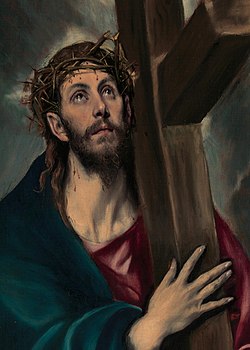
Back إكليل الشوك Arabic اكليل الشوك ARZ Цярновы вянок Byelorussian Трънен венец Bulgarian Corona d'espines Catalan Trnová koruna Czech Dornenkrone German Ακάνθινος στέφανος Greek Dornokrono Esperanto Corona de espinas Spanish

According to the New Testament, a woven crown of thorns (Ancient Greek: στέφανος ἐξ ἀκανθῶν, romanized: stephanos ex akanthōn or ἀκάνθινος στέφανος, akanthinos stephanos) was placed on the head of Jesus during the events leading up to his crucifixion. It was one of the instruments of the Passion, employed by Jesus' captors both to cause him pain and to mock his claim of authority. It is mentioned in the gospels of Matthew (Matthew 27:29),[1] Mark (Mark 15:17)[2] and John (John 19:2, 19:5),[3] and is often alluded to by the early Church Fathers, such as Clement of Alexandria, Origen and others, along with being referenced in the apocryphal Gospel of Peter.[4]

Since around 400 AD, a relic has been venerated as the crown of thorns. The Franc Emperor of the Middle-East kept it in his on chapel. Louis IX acquired it in 1239 from the emperor Baldwin Il, who was financially in debt due to heavy military expenses. Louis IX built the Sainte-Chapelle as a monumental reliquary to house the relic. Transferred to the French National Library during the Revolution of the 18th century, the crown of thorns has been displayed at Notre-Dame de Paris since 1804, where it is venerated each first Friday of the month. The crown is made of reeds, formed into a circle and attached with reed fastners. Originally, branches of zizyphus. On 15 April 2019, it was rescued from a fire and moved to the Louvre Museum.[6] In December of 2024, a ceremony marking the relic's return to Notre Dame Cathedral was led by a procession attended by members of the Equestrian Order of the Holy Sepulchre.[7]
Numerous other relics are purported to be from the original crown of thorns.[8] Both the authenticity of the relics and the practice of venerating them have been criticized by some Christians, including by Protestant reformer John Calvin.[9]
- ^ Matthew 27:29
- ^ Mark 15:17
- ^ John 19:2, John 19:5
- ^ Walter Richard (1894). The Gospel According to Peter: A Study. Longmans, Green. p. 7. Retrieved 2022-04-02.
- ^ Davisson, Darrell D (2004). Kleinhenz, Christopher (ed.). Medieval Italy: An Encyclopedia. Vol. 1. Abingdon, England: Routledge. p. 955. ISBN 9780415939294.
- ^ Clicquot, Athénaïs (9 September 2019). "Notre-Dame: la couronne d'épines à nouveau présentée à la vénération des fidèles" (in French). Retrieved 2020-09-15.
- ^ "'Crown of Thorns' relic returns to Notre-Dame cathedral". 2024-12-13. Retrieved 2025-05-18.
- ^ Cite error: The named reference
thurston1908was invoked but never defined (see the help page). - ^ "How did Jesus's (alleged) crown of thorns come to be housed in Notre Dame?". ABC News. 2019-04-17. Retrieved 2025-05-18.